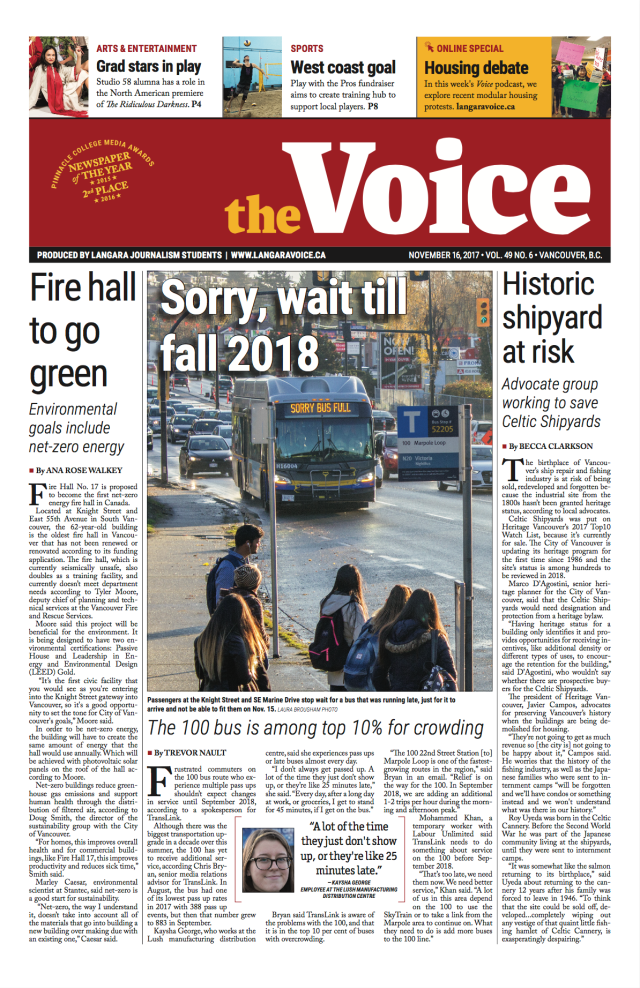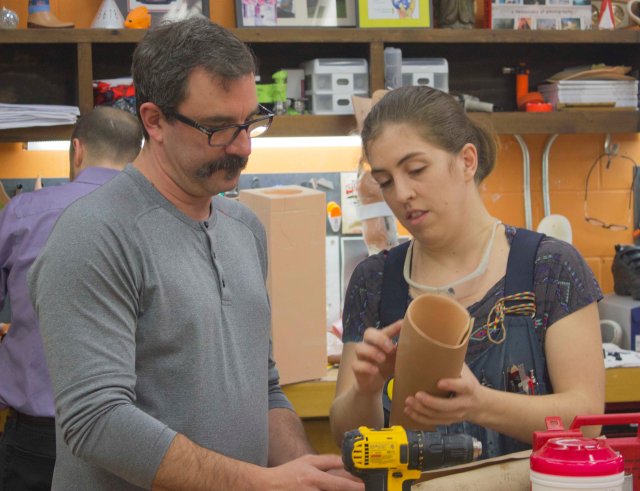
Category: South Vancouver News
South Vancouver business Barber Prosthetics exploring the limits of 3D printing
When first walking into Barber Prosthetics Clinic, it might seem daunting entering directly into the workshop, but that impression is very short lived. As soon as you encounter David Moe he brings a sense of fun and relaxation to the room.

Moe is the owner of Barber Prosthetics, a South Vancouver company that does research in the field of prosthetics, as well as making them, and is starting to explore 3D printing.
Moe has been around prosthetics his whole life. His father used to work in the Children’s Hospital in Calgary before buying his own practice in Edmonton. The practice became a family business, and through his time at that practice, he worked with his father, two of his uncles, his grandmother, his sister and his brother.
“I started at 14 and I’m still here,” Moe said. When his father bought a practice in 1979, “I started going there and sweeping the floor at the end of the day. I’d grab the bus and I’d go down to work, my dad would stay a half hour late so I that I could get two hours worth of work in.”
Here is Moe describing how he first got an interest in prosthetics:
No two patients the same

Every patient is approached differently, because some techniques used for one patient can’t be used in the same way for another, according to Moe.
“Each person is like a puzzle,” Moe said. “Our role is to know that there is a puzzle, and then help the people to figure out which piece is the next piece that’s actually going to go in to that puzzle.”
Hoping to improve the profession

Moe hopes that by the end of his working career, he leaves the profession better than he entered it, whether through his work at Barber Prosthetics, or his time as a prosthetics instructor at BCIT.
“I’m always striving to see if we can be better, to see if we can raise the bar, to see if we can develop the highest standard of patient care that’s available,” Moe said. “My goal is to hopefully leave my profession better than I entered it.”
3D printers in the prosthetic industry

Barber Prosthetics got a 3D printer in November of last year, but Moe is hoping to answer some questions about the strength of the sockets, or the piece that joins the prosthetic to the residual limb, before giving any clients anything 3D printed. Moe is doing research with the National Autonomous University of Mexico and BCIT on this topic.
“We just created 48 sockets, we’ve just broken them all, and now we have the data to compare 3D printed against how we create them now and we’ll be able to write a paper,” Moe said. “Once we know it’ll be strong enough, I think I’ll have a far more likelihood of allowing people to walk them, and we’ll usher in the 3D printing in a safe, controlled manner.”
Workshop Decor

Decorations are hung up around the workshop, to give patients something to look at. One of those decorations is a ruler twisted due to its uselessness, according to Daryl Murphy, prosthetic technician at Barber Prosthetics.

“It was a ruler and it had a whole bunch of felt marks on it,” Murphy said. “Then [somebody used] some acetone to rub that mark off, and it took a whole swath of the actual increments off, and it was like ‘well this just became useless.’ So we just bent it into a little shape.”
Red-Light cameras passed up for Vancouver’s most dangerous intersection

Knight Street and SE Marine will not see safety improvements after 231 vehicle accidents in 2015
Plans to improve safety at Vancouver’s intersection with the highest collision rate do not include red-light cameras, despite evidence that they reduce collisions.
With construction starting in June, Knight Street and SE Marine Drive will gain a new left-turn lane onto Knight Street Bridge, a new traffic light and will ban left turns onto Borden Street. The intersection, which saw 231 accidents in 2015, has the most crashes in Vancouver according to ICBC.
Simon Goppel, a warehouse worker at Matrix Logistics Services Ltd., almost got hit by a car at the notorious intersection earlier this month.
“I was heading down the street and at this moment a fancy sports car drove with much too much speed, it almost killed me, I’m not kidding, it was driving so fast there. Not obeying the red light or green light,” Goppel said, adding that it would help if drivers were fined. “It would be much safer [if] the car gets punished. The next time it will stop at the red light.”
Red-light cameras can improve safety
Transport Canada said red-light cameras can reduce the number of fatal red-light collisions by 35 per cent, but the intersection’s safety upgrade plans don’t include one.
Bruce Taylor, a forklift operator for C2C Premium Seafood, has seen many near-accidents at the intersection. Like Goppel, he also thinks a red-light camera could help.
“People after a while will know that camera is there,” he said. “Little by little it will gradually decrease the number of people that try to run red lights, or run the amber lights.”
Intersection “not suitable” for camera
Danielle Pope, a spokesperson for the Ministry of Transportation and Infrastructure, said the intersection’s layout with an overpass and on-ramp and merging traffic made it challenging.
“The SE Marine Drive and Knight Street Bridge area is indeed busy with lots of traffic,” Pope said in an email. “It was not deemed suitable for a red-light camera.”
Homemade soaps vegetarian-friendly option

Local business hosts how-to workshops on handmade, plant-based soaps
Making handmade soap is an option for vegetarians who prefer to use high quality bars that do not have animal-based ingredients.
People can make soap with plant and vegetable fats, which they often choose to do because the product they make agrees with their lifestyles and complements their principles.
“[People come to the workshops] because of the quality and the process and the control they have over the ingredients not necessarily because it’s vegetarian,” said Kate Duda, the owner of Plenty + Spare, a Vancouver-based soap-making company.
A reduced carbon footprint
“You can make an incredibly high-quality soap with any kind of scrap animal fats that you’ve sourced locally and in that case you’ve reduced your shipping footprint, you’ve reduced your packaging footprint, you’ve avoided palm oil, that sort of thing,” said Duda, who teaches soap-making classes.
The option to make soap with plant oils attracted Jennifer Bigler.
“I’m vegetarian, I don’t eat meat, so I don’t want to be using animal products on my skin,” said Bigler, who works at Cambridge Uniforms.
“It’s handmade, there’s natural glycerine in the soap, there’s no added unnecessary ingredients,” Duda said, explaining a main difference between conventional soap sold at a grocery store and handmade soap.
Homemade option cost-effective
Buying ingredients to make soap at a bulk supply shop can be less expensive than buying them at a grocery store, and Duda encourages people to buy the equipment they’ll need to make soap at home from a second-hand store.
Rick Havlak, owner of Homestead Junction, where soap-making workshops are taught, said the workshop is important because people become more familiar with a product they use everyday.
“Soap making was actually one of the first workshops we offered, back in 2012 when we first opened,” Havlak said. “Almost everybody uses [soap], and almost nobody really understands how it’s made.”
Homestead Junction most recently hosted a soap-making workshop on March 7.
Metro Theatre’s production of Guilty Conscience blurs the lines of reality
Reported by Laura Brougham
Finding the difference between reality and imagination is the premise for Metro Theatre’s new production Guilty Conscience, running March 4-25.
Francis Boyle, a Studio 58 alumni, takes on the role of criminal defence lawyer, Arthur Jamison who plans to murder his wife, Louise, to avoid paying alimony. The play takes the audience through a succession of scenarios in his mind where Jamison commits and gets away with murder. It soon becomes increasingly difficult to separate truth from fiction.
Cast and crew already knew each other
With such intimate themes at play, having a cast and crew already familiar with one another proved to be beneficial. Joseph Balint who plays the prosecutor, reunites with his high school drama teacher, Don Briard.
“The reason why I took the part was that Don was directing it,” Balint said. “I wanted to see what it was like to interact with him as an adult, as opposed to him directing me as a child.”
Balint said, for his character, the script made it easy to distinguish between reality and imaginary.
“It was fairly easy, just reading and maintaining what the script says,” he said. “The script lends itself both to the deception and the reveal of that deception.”
Audience decides what is real or imagined

Boyle said the audience will wonder which scenes are real, while Arthur struggles with his marriage.
“Arthur has these imaginations on how he would like to do away with his wife because he’s not in a very good marital situation,” Boyle said. “You always wonder what’s real and what’s imaginary, or is this finally the real one?”
Ultimately, it’s the audience who will determine where the line is between what is real and what is imagined.
“We won’t know whether we’ve achieved it until we have an audience,” Briard said. “Is the audience going to be confused or intrigued? We’re just going to cross our fingers and turn out the lights and see what happens.”
Journalists need to change how they report on stories

The media needs improvements, but is more stable than the public may think.
Journalism is based on reporting facts, and going into the field to interview people, but the Internet has changed the way stories are reported on. Now many stories can be done without leaving the newsroom, changing the dynamic between reporters and the public.
Dale Bass, board chair and the B.C./Yukon representative for the Canadian Association of Journalists, thinks journalists spend too much time in newsrooms to understand their readers’ interests.
“[The media] needs to go back to the way it used to be, go back to when we weren’t just writing and rewriting press releases,” said Bass. “If you’re a reporter, you have to get off your butt, get out of your office, talk to people, listen to people, and answer their questions.”
Is objectivity the best policy for the media?
Bass wonders if the media should remain objective.
“I wonder sometimes about the veil of objectivity we all have, and whether we need to continue promulgating that,” said Bass. “Should journalists protest? I don’t know.”
Rob Dykstra, a retired Langara journalism department chair, believes journalists should “have a lot of integrity in terms of presenting information that’s based on facts, and not working opinions into stories.”
Dykstra believes many news outlets rely on company-sponsored press releases to fill pages.
“Because the media are generally so short staffed these days, they will generally pick those up and run them, not realizing…the vested interest behind that story,” Dykstra said.
Higher standards for news outlets than others
Steven Malkowich, executive vice president of Alberta Newspaper Group, accused blogs of contributing to damaged reputations of the media.
“If we write something that is fake, or disingenuous, we’ll get sued,” said Malkowich. “Someone will sue us for slander or libel, but on the internet, you can just say whatever, and nobody gets sued. There’s no deterrent to doing it.”
According to Dykstra, this goes back to journalism principles.
“[This] really is a matter of re-establishing public trust in journalism, based on the integrity of fact-based journalism.”

